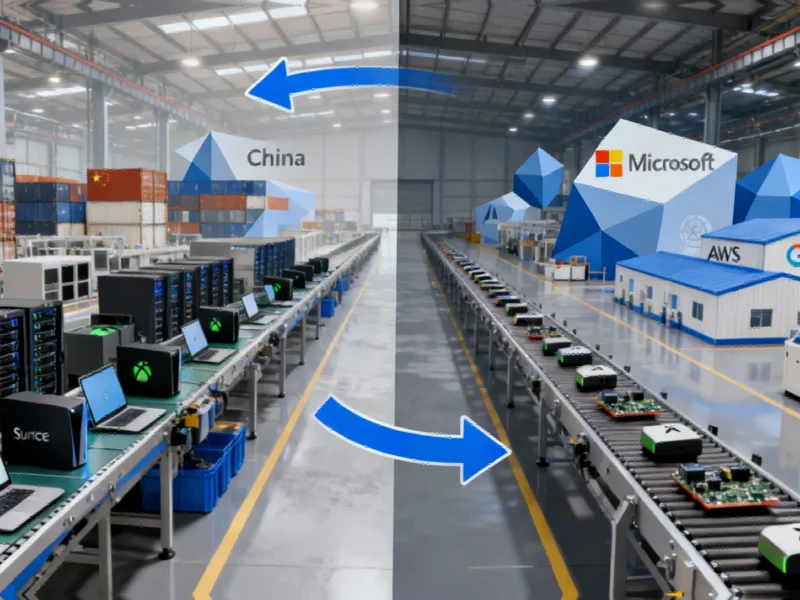The global technology industry is undergoing its most significant supply chain transformation in decades, with Microsoft joining the growing list of tech giants reevaluating their manufacturing presence in China. According to sources familiar with the matter, Microsoft has initiated plans to shift production of its Surface laptops and data center servers outside Chinese borders, marking a substantial strategic shift that reflects broader geopolitical tensions and trade uncertainties.
This development represents part of a broader tech exodus from Chinese manufacturing hubs that has been accelerating throughout 2024. The move comes as former President Donald Trump’s administration successfully pressured numerous American technology companies to reduce their dependence on Chinese production capacity, with Microsoft’s decision potentially serving as a bellwether for the industry’s future direction.
Microsoft’s Phased Manufacturing Transition
Microsoft has reportedly instructed multiple key suppliers to prepare for “out of China” production lines for its flagship Surface laptop computers and enterprise-grade data center servers. According to insiders who spoke to Nikkei Asia, the technology behemoth aims to begin manufacturing components and assembling new notebook computers and servers outside China as early as 2026.
The transition appears to be already underway, with sources indicating that Microsoft shifted a substantial portion of its server production out of China earlier this year. Next in line for relocation is reportedly the manufacturing of Xbox gaming consoles, suggesting a comprehensive supply chain restructuring rather than piecemeal adjustments.
Industry-Wide Movement Gains Momentum
Microsoft isn’t alone in this strategic pivot. Amazon Web Services is currently conducting evaluations to move production of its AI data center servers outside Chinese territory while simultaneously reducing procurement from long-established Chinese suppliers. Meanwhile, Google has reportedly requested that suppliers expand server production capacity in Thailand, indicating a broader Southeast Asian redistribution of manufacturing capabilities.
This trend toward supply chain diversification reflects what industry analysts describe as a fundamental realignment of global technology manufacturing. As technology companies increasingly seek to control their entire ecosystem, geographical risk mitigation has become a paramount concern for corporate strategists.
Geopolitical Pressures Intensify
The technology sector has emerged as the primary battleground in the ongoing trade tensions between Washington and Beijing. American tech giants find themselves caught in the crossfire, facing potential disruption to their extensive Chinese-based supply chains and manufacturing operations.
The situation has been exacerbated by Trump’s threatened implementation of 100% tariffs on Chinese imports starting in November, coupled with proposed export controls on critical software. These measures would significantly jeopardize the operations of American technology companies maintaining substantial manufacturing presence in China.
Trump’s administration has demonstrated consistent pressure on U.S. companies to decouple from China, exemplified by his demand for Intel CEO Lip-Bu Tan’s resignation over perceived Chinese ties. The administration only relented when Intel agreed to sell a 10% stake to the U.S. government, highlighting the intense political pressure facing technology leaders.
China’s Strategic Countermeasures
Beijing has not remained passive in this escalating trade conflict. China has strategically leveraged its dominance in critical resources, recently tightening export controls on rare earth minerals that form the technological industry’s backbone. These minerals are particularly crucial for computer chip production, giving China substantial influence over global technology manufacturing.
The new regulations require companies to obtain Chinese government licenses before exporting any product containing more than 0.1% China-sourced rare earths. Given that China mines 70% of the world’s rare earth minerals and refines approximately 90%, these controls represent a powerful economic weapon. This regulatory environment is creating new challenges for manufacturers, with many seeking alternative locations that offer more predictable operational frameworks.
Antitrust Actions Compound Challenges
China has additionally deployed antitrust investigations as another tool in its economic arsenal. Last month, Chinese antitrust regulators concluded a preliminary probe finding Nvidia in violation of the country’s antimonopoly laws. Most recently, Qualcomm faced scrutiny when China’s top market regulator launched an investigation into the American semiconductor company’s acquisition of Israeli startup Autotalks.
These regulatory actions create additional uncertainty for American technology companies operating in China, further incentivizing the diversification of manufacturing and supply chains beyond Chinese jurisdiction. The combination of trade tensions and regulatory pressure is accelerating what industry observers describe as a fundamental restructuring of how technology companies approach global operations.
Practical Implementation Challenges
Despite the political and economic pressures, disentangling from Chinese supply chains presents formidable practical challenges. Sources familiar with Amazon Web Services’ situation noted that “removing Chinese suppliers from the supply chain is very difficult in real practice,” highlighting the deeply integrated nature of global technology manufacturing.
China’s manufacturing ecosystem offers unparalleled scale, expertise, and infrastructure that cannot be easily replicated elsewhere. The country has spent decades developing sophisticated supply networks that support everything from component manufacturing to final assembly across multiple industries, creating dependencies that extend far beyond simple cost considerations.
As Microsoft and other technology giants navigate this complex landscape, their decisions will likely reshape global manufacturing patterns for years to come. The coming months will prove critical in determining whether these initial moves represent temporary adjustments or the beginning of a permanent reconfiguration of the world’s technology supply chains.
Based on reporting by {‘uri’: ‘gizmodo.com’, ‘dataType’: ‘news’, ‘title’: ‘Gizmodo’, ‘description’: ‘We come from the future.’, ‘location’: {‘type’: ‘place’, ‘geoNamesId’: ‘5128581’, ‘label’: {‘eng’: ‘New York City’}, ‘population’: 8175133, ‘lat’: 40.71427, ‘long’: -74.00597, ‘country’: {‘type’: ‘country’, ‘geoNamesId’: ‘6252001’, ‘label’: {‘eng’: ‘United States’}, ‘population’: 310232863, ‘lat’: 39.76, ‘long’: -98.5, ‘area’: 9629091, ‘continent’: ‘Noth America’}}, ‘locationValidated’: False, ‘ranking’: {‘importanceRank’: 174039, ‘alexaGlobalRank’: 1756, ‘alexaCountryRank’: 545}}. This article aggregates information from publicly available sources. All trademarks and copyrights belong to their respective owners.



